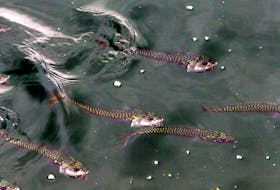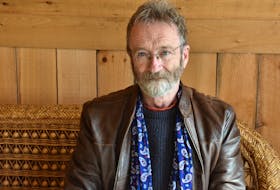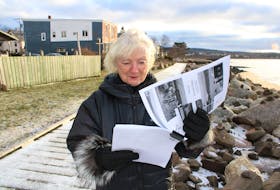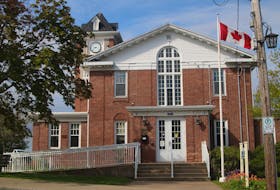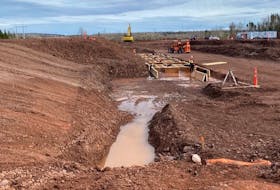PORT HASTINGS, N.S. — As the final train ferry crossed the Strait of Canso 65 years ago with the arrival of the Canso Causeway, it launched a new era of easier travel between Cape Breton and mainland Nova Scotia but it also killed the Strait of Canso area’s largest employer.

The final run by the Scotia II ferry took place on May 14, 1955, shortly before the opening of the Canso Causeway. At the time, both Point Tupper and Mulgrave were active communities, but the loss of their largest employer with the end of the rail ferries devastated both economies and had much larger ripple effects that are still felt today.
“At that time all of these train cars had to be disassembled over in Mulgrave, put on the ferry, taken off over on this side, the handling of the trains and the inclines getting into Mulgrave and moving things, it required a lot of men. There were upwards of a couple of hundred men,” noted local community historian Yvonne Fox.
Fox is the driving force behind the Strait Area Museum, formerly known as the Port Hastings Museum. The museum’s own existence is strongly tied to the history of the causeway, as it was started as the crossing's 25th anniversary was marked.
“Decided I'd better do something to recognize the event that was such a terrific blow to the residents of the Strait area communities 65 years ago this coming Thursday,” Fox wrote on the museum’s Facebook page this week. “It was particularly bad for Mulgrave on the mainland side of the Strait as well as Point Tupper on the Cape Breton Island side.”
While other historical societies may focus their work on different areas of the culture, traversing the Strait of Canso has always been at the heart of their museum’s efforts, Fox said.

“That’s why we’ve always been trying to find out what the history was of crossing that waterway historically,” Fox said. “The Mulgrave-Port Hawkesbury, Mulgrave-Point Tupper links were something that we always were compiling the history of.”
A ribbon-cutting was held for the first train that came across the new causeway on May 14, but the span had to open to vehicular traffic earlier than originally intended a few days later on May 20 when the John Cabot ferry caught fire at the wharf in Port Hawkesbury, Fox explained.

She noted one of the more poignant photos in the museum’s collection is a picture of representatives of the 370 children in Mulgrave carrying a banner that read, “Our message to you – We hope you enjoy the causeway but help us to survive.”
While some who lost their jobs found work on the railway in areas such as Sydney, others had to travel for other work, leaving their families behind because their homes were now worthless, Fox said.

That was what prompted Leonard O’Neil, then the mayor of Mulgrave, to bring together other local leaders such as Art Langley of Port Hawkesbury to set about enticing a large industry to the region, eventually attracting Stora to construct a pulp mill in Point Tupper, which opened in 1962.
The construction of the causeway itself, rather than a bridge, was integral to that effort, Fox added, because it created the ice-free harbour. Today, a small number of homes remain in Point Tupper, along with heavy industry such as what is now Port Hawkesbury Paper and Cabot Gypsum. The Strait region’s economy remains heavily reliant on the forestry industry that was attracted following the loss of the ferry service.
“If it hadn’t been for the causeway and their efforts, we wouldn’t be living here today,” she said.




